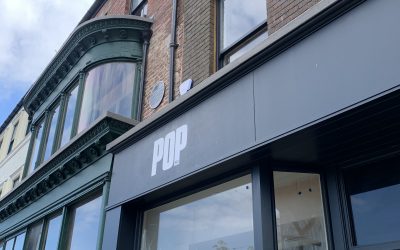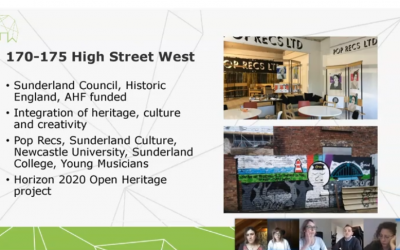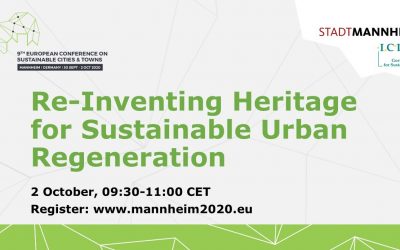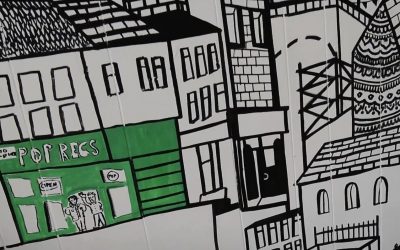High Street, Sunderland
Great Britain
United Kingdom
The Sunderland High Street West CHL activities – carried out by the Tyne & Wear Building Preservation Trust (TWBPT) and Newcastle University – are part of a bigger project. This bigger project, led by TWBPT, aims to get three buildings on the edge of Sunderland city centre back into long term sustainable socio-cultural use that is beneficial to the neighbours and the wider local community. The buildings were originally built as houses in the 1790’s, and their ground floors converted to retail/office very early on. At the moment they are worthless in terms of money and the rent they could produce is unlikely to provide the financial return to make restoring the buildings commercially viable.
The three buildings are now owned Freehold by the TWBPT. They were gifted (sold for 1 pound) to the TWBPT by Sunderland City Council in February 2018. Restoration to make them usable means there is a need for funding (it will be a mix of grants, crowd funding, and possibly a loan, as well as non-financial investment by volunteer work and donation of material) local authority support. To achieve this funding, the TWBPT are required to provide public value and work strategically with various partners in the wider area. When they are back into use, the buildings are expected to create wider regeneration potential for the area, with socio-cultural public use, visible investment and improvement, and through collaboration with other actors in the area. Once restored, the buildings are expected to be a really necessary and positive addition to the street and help the revitalisation of the area, e.g. by increased footfall, floor space brought back into use, and local pride.
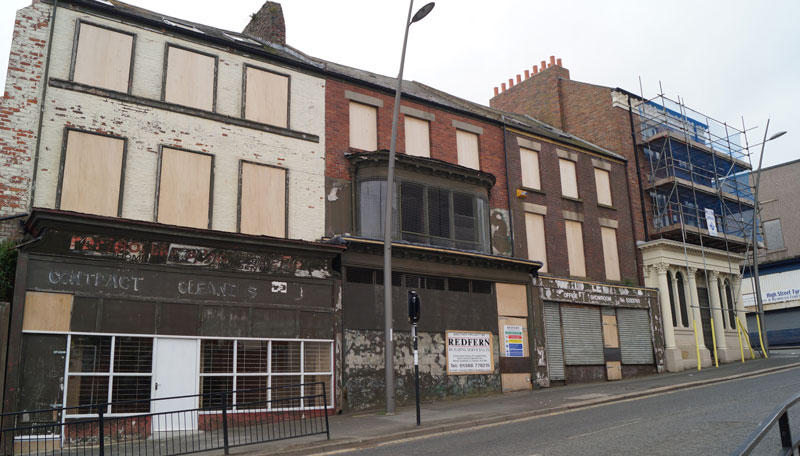
Aims:
• For the next two years the main aim is to re-open the complete ground floor of all 3 buildings to enable them to be used for a mixture of permanent and temporary uses, and support local organisations in using the buildings.
• Build / strengthen the local network, and develop a sustainable partnership (organisation) to run the buildings in the long term.
• Help built local capacity, and create a place for community support
• To explore the appropriate mix of innovative and traditional funding mechanisms, including a combination of e.g. community share issues, community bonds and crowd-funding.
• Developing new engagement and promotional tools, and strategies for funding (and phasing) which allow for the inclusion of different sources to contribute to regeneration through conservation of this part of Sunderland, working closely with the residential neighbouring community as well as the wider cultural sector in the city.
• As the project is seen as a key opportunity to extend the economic regeneration progress of the City Centre Investment Corridor east along the High Street West, it is important to create links with the various other development projects in the city.
• To act as a demonstrator project for innovative financial models and organization that can be subsequently replicated elsewhere by TWPBT and other organizations.
Work so far:
The buildings had been transferred from the Local Authority to the TWBPT (February 2018) and the Urgent Works (funded by Historic England’s Repair Grant Scheme) had been undertaken (March-April 2018). The main aim for the first 6 months of the CHL (June – Nov 2018) was to develop a Local Action Plan including a plan and a timeline for the upcoming activities. This was achieved successfully and has been very useful to develop and guide the project.
The initial request to save the building came from Sunderland City Council. Building on the TWBPTs experience of delivering restoration projects, it was clear that this project would not thrive with grant money only, needed was the building partnerships, local capacity, and community support. OpenHeritage, in terms of financial support, capacity building, and the direct collaboration with Newcastle University locally, has provided the opportunity to develop this, and work with the community to gain their support as well as provide the environment for the necessary capacity building, whilst building a wider partnership network and developing a collaborative positive impact in the area. During Heritage Open Days for example, various activities were organised and about 200 local people came in to join some of the events or see the exhibition.
The activities carried out so far include developing strong local collaborations with various partners (e.g. Pop Recs, Sunderland City Council, Sunderland Culture, We Make Culture, Back on the Map, and various local creatives / artists) and a genuine public engagement that has occurred over this period. With all these activities, TWBPT had to justify that temporary use can develop into a permanent fixture. As a reward of these activities undertaken by the CHL, TWBPT has been successfully securing £770.000 (the majority of this funding came from Historic England and Sunderland City Council, as well as Architectural Heritage Fund, additional grants came from the Pilgrim Trust and the Garfield Weston Foundation), in capital funding and the selected construction company is currently onsite carrying those out!
Challenges ahead:
• Economic and social problems: Sunderland has high unemployment rates, an ageing population, and the local authority is under austerity pressures.
• State of the heritage assets: Despite its significant heritage value, lack of maintenance and care by the previous owner led to vacancy and poor repair.
• Re-use: It is a challenge to find a form of adaptive re-use of the buildings that is financially and socially sustainable yet maintains the historic fabric and contributes to the wider regeneration of this part of the city.
Contact:
Martin Hulse
martin@twbpt.org.uk
Take part in the work:
Visit Lab
To download:
Local Action Plan Sunderland
Blue plaque revealed to commemorate anti-slavery activity
Sunderland Lab building receives a blue plaque to commemorate Quaker women's anti-slavery activism on June 30. “Sunderland’s Quaker women led the local anti-slavery campaign from the 1790s. They...
Sunderland Lab featured in an article on artistic and curatorial power in cities’ historic spaces
OpenHeritage's Sunderland Lab was featured in an article “Artistic and Curatorial Power in Cities’ Historic Spaces” written by ICLEI cultural coordinator Cristina Garzillo and published in the...
Reinventing Heritage for Sustainable Urban Regeneration: OpenHeritage at Mannheim2020
OpenHeritage joined the session ‘Re-Inventing Heritage for Sustainable Urban Regeneration’, which took place on 2 October as part of Mannheim2020 – the 9th European Conference on Sustainable Cities...
Re-Inventing Heritage for Sustainable Urban Regeneration: join our Mannheim2020 session
OpenHeritage invites you to join the session ‘Re-Inventing Heritage for Sustainable Urban Regeneration’ taking place on 2 October as part of Mannheim2020. Mannheim2020, the 9th edition of the...
Restoration works in Sunderland Labs
170-175 High Street West in Sunderland is long overdue for some restoration works! Tyne & Wear Building Preservation Trust now owns the building, and is working hard to gather the funding needed...

